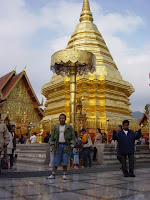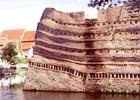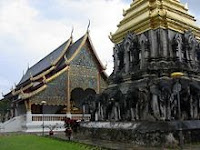 |
| Doi-Suthep |
Chiang Mai is Thailand’s second largest city, covering some 20,000 square kilometres. With a population of only 250,000 in the city, however, it does not even come close to the size of Bangkok.Many visitors stay in Chiang Mai longer than planned because of the high quality and low cost of accommodation, variety of cuisine and shopping, cool nights, international atmosphere and friendly people. With the increasing number of cultural and spiritual learning experiences available to visitors, Chiang Mai has become more than just a quick stop on the tourist trail.It lies about 800 kilometres north of Bangkok on a mountainous plateau 310 metres above sea level. The city stands along the Ping River, a major tributary of Bangkok’s Chao Praya River. Chiang Mai City also serves as the capital of Chiang Mai Province, which is home to around 700,000 people.
The province of Chiang Mai contains over 300 ancient temples, and some of the country’s oldest. Although rich with history and legendary, mystical attributes, Chiang Mai has developed into a modern, cosmopolitan city of friendly people and manageable size. Its central location makes Chiang Mai an excellent base for exploring the north of Thailand.Many people flock to Chiang Mai to do some trekking into the mountains or rafting down rivers. Others come purely for the fantastic shopping for handicrafts and furniture. Chiang Mai’s elegant hotels tucked in valleys and hillsides provide perfect romantic getaways or soul-searching retreats. As everywhere in this country, Thai cooking is superb and you’re sure to find a restaurant to suit your tastes.Getting there is relatively easy. There are flights and trains from Bangkok daily as well as a good bus service. If your stay in Thailand is a short one, it’s only an hour’s flight from Bangkok to Chiang Mai.The mountains are taller here than anywhere else in Thailand. Mt. Inthanon, located 106km from Chiang Mai at 2565 metres is the tallest peak in the country. The cooler plains provide fertile soil where fruits, vegetables and tobacco are grown.It would be difficult to find a city that reflects more of the country's diverse cultural heritage than Chiang Mai. Tour buses crowd stunning temples, ablaze with the colour of saffron and humming with the chanting of monks. Hill tribe groups sell their wares in the busy market and local villages. Narrow streets lined with ornately carved teak houses lie in the shadow of contemporary skyscrapers.
Chiang Mai's heart is its Old City, an area surrounded by remnants of ancient walls and moats originally constructed for defence; yet Chiang Mai is a modern city with a growing infrastructure of modern shopping malls, international restaurants and condominiums. The contrast is part of the town's charm.
Whether you plan on a long visit or short, you will be touched by the friendliness of the people and the beauty of Chiang Mai.
 |
| Chang Mai wall_city |
History
Chiang Mai's historic strength derived from its important strategic location near a southern branch of the ancient Silk Road. Long before the modern influx of foreign visitors the city served as an important centre for handcrafted goods, umbrellas, jewellery (particularly silver) and woodcarving.Chiang Mai owes her existence to the Ping River which provided the trade route which could be extended beyond the wall of mountains that surround the Chiang Mai valley. It became a channel for trade from China and Burma to the Gulf of Siam. The wide, fertile valley, able to support a large number of people, became the basis of political power in the feudal kingdom of Lanna (Kingdom of One Million Rice Fields).Archaeological excavations show the area has been inhabited by humans for over two thousand years. However, the city of Chiang Mai was founded in 1296 by King Mengrai as the capital of the first independent Thai state, Lanna Thai. It became the cultural and religious centre of the northern Tai, who had migrated from southern China to dwell in Thailand, and remained so throughout the turbulent period of recurring Burmese attacks. The Burmese finally captured Chiang Mai in 1556 and occupied it until King Taksin retook the city in 1775, driving the Burmese forces back to near the present border. Burmese influence on religion, architecture, language, cuisine, and culture, however, remains strong.Local princes, called chao, remained in nominal control of the city in the late 18th and early 19th century, though they deferred to the King of Siam in Bangkok. In 1874, King Chulalongkorn (Rama V), concerned with encroachment by the British (who had teak-logging interests as occupiers of Burma) and fearful of a conflict with them, sent a commission to Chiang Mai, which eventually limited the power of the local princes and brought the Lanna Kingdom further under the control of the central government in Bangkok. In 1939, the city was formally and fully integrated into the kingdom of Thailand, becoming the administrative centre of the north. In 1996, the city celebrated its 700th anniversary.
 |
| Wat_Chiang_Man |
IN CHIANG MAI
Doi Angkhang, Doi Suthep, Doi Inthanon National Park, Elephant shows, Ob luang, Phu Ping Palace, Snake Farm, Chiangmai Zoo, Samoeng, Huay Kaew Waterfall, Khun Mae Ya, Travel, Hotels, Resorts, Tours, Waterfalls Chiangmai, Doi Suthep, Doi Pui, Doi Inthanon National Park, Huai Nam Dang, Mae Sa Waterfall, Hotels, Resorts and Travel.
ไม่มีความคิดเห็น:
แสดงความคิดเห็น